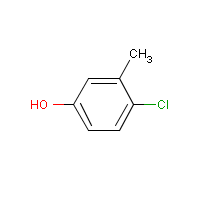p-Chloro-m-cresol
Agent Name
p-Chloro-m-cresol
CAS Number
59-50-7
Formula
C7-H7-Cl-O
Major Category
Other Uses

Synonyms
2-Chloro-5-hydroxytoluene; 2-Chloro-hydroxytoluene; 3-Methyl-4-chlorophenol; 4-Chloro-1-hydroxy-3-methylbenzene; 4-Chloro-3-cresol; 4-Chloro-3-methylphenol; 4-Chloro-5-methylphenol; 4-Chloro-m-cresol; 6-Chloro-3-hydroxytoluene; 6-Chloro-m-cresol; Aptal; Baktol; Baktolan; CMK; Candaseptic; Chlorcresolum; Chlorkresolum; Chloro-3-cresol; Chlorocresol; Chlorocresolo; Chlorocresolum [INN-Latin]; Chlorocresolum [Latin]; Chlorokresolum; Clorocresol [INN-Spanish]; Clorocresol [Spanish]; Clorocresolo [DCIT]; Ottafact; PCMC; Parachlorometacresol; Parmetol; Parol; Peritonan; Phenol, 4-chloro-3-methyl-; Preventol CMK; Raschit; Raschit K; Rasen-Anicon; p-Chlor-m-cresol; p-Chloro-m-cresol; p-Chlorocresol; [ChemIDplus] UN2669 [CHEMINFO]
Category
Biocides/Disinfectants
Description
White to slightly pink crystals; Odorless or slightly phenolic odor; [CHEMINFO]
Sources/Uses
Used as a disinfectant, germicide, preservative, and fungicide; [HSDB]
Comments
Animal evidence: corrosive to eyes and a possible skin sensitizer; [CHEMINFO] Can cause redness to the skin and severe burns to the eyes; Can reach dangerous air concentrations if heated above room temperature; [ICSC] Injury to the liver and other organs is observed in high-dose animal studies; Methemoglobinemia has been reported in human poisoning cases; [HSDB] Chlorocresol causes contact urticaria (both immune and non-immune); [Kanerva, p. 219] Danger of skin sensitization; [MAK]
Reference Link #1
Biomedical References
Exposure Assessment
Vapor Pressure
0.05 mm Hg
Explanatory Notes
VP from ChemIDplus;
Reference Link #2
Adverse Effects
Skin Sensitizer
Yes
Methemoglobinemia
MetHgb is secondary toxic effect
Hepatotoxin
Hepatoxic (a) from occupational exposure (secondary effect) or (b) in animal studies or in humans after ingestion
Dermatotoxin
Skin burns
Diseases, Processes, and Activities Linked to This Agent
Diseases
Occupational diseases associated with exposure to this agent:
Processes
Industrial Processes with risk of exposure: